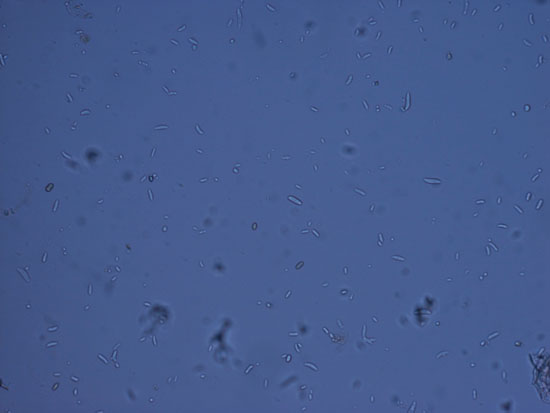Issue 8, June 11, 2012
Daylily leaf streak (Aureobasidium microstictum)
Daylilies are a common ornamental plant in Illinois, but when infected with daylily leaf streak, this beautiful plant can be reduced to a withered mess. Daylily leaf streak disease is caused by the fungus Aureobasidium microstictum. It is most widespread under wet and cool conditions.
The disease is named after the streaks that run along the center vein of the leaf. These streaks are yellow in color, which can darken as the tissues die and form brown-colored, elongated areas on the leaves. The streaks are usually located at the tip of the leaves. In severe cases, the whole leaf may shrivel up and die. Care should be taken to differentiate daylily leaf streak from daylily rust. Both diseases have symptoms that are very similar in appearance, but daylily rust produces orange pustules.

Symptoms of daylily streak – note the brown necrotic lesions amidst the chlorotic area.

Symptoms of daylily leaf streak--the leaves will display symptoms of shrivel.
Under the microscope, Aureobasidium microstictum will appear as spores of different sizes. However, from time to time, the basidium can be observed.

Spores of Aureobasidium microstictum.

Basidium structure
To combat this disease, it is highly recommended that one concentrate on cultural controls. To manage daylily leaf streak disease, one should remove all of the past-year's foliage since the fungus can overwinter on old foliage. Because the fungus spreads through water, growers could space plants further apart to minimize rain splash between plants and allow proper air circulation. Overcrowded growing situations are more likely to become diseased. This disease is more likely to be severe early in the growing season. It is also advisable to not work with the plants when they are wet. If you are watering, it should be done at the base of the plant, not from the top! This disease should not be a major issue if the weather is dry. Temperatures above 90 degrees limit disease development.
Fungicide application can be helpful in controlling the disease and protecting new growth. However, ensure that the fungicide is specifically manufactured for daylilies or daylily-related species.
Other useful links:
http://www.freshfromflorida.com/pi/enpp/pathology/pathcirc/pp376.pdf (Adobe PDF)
http://www.sar-headsup.com/trials/daylily/Day_Lily_article_MDFGA_2002.pdf (Adobe PDF)
(Stephanie Porter and Zu Dienle Tan)
Authors:
Stephanie Porter
Zu Dienle Tan